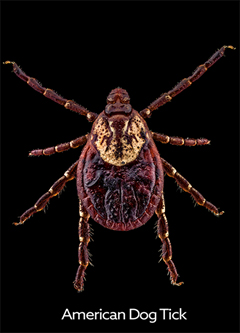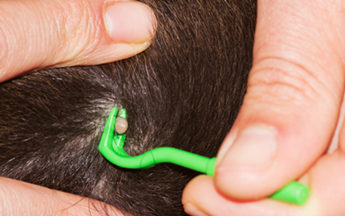While snow may still blanket parts of Colorado’s front range for weeks to come, the arrival of warmer days and taller grasses means the threat of ticks is not far away. These parasites feed on the blood of their host and can in turn transmit diseases to your pets or even you. They are prolific breeders, and their life cycles can extend through multiple seasons. In fact, some tick species can be active on winter days if the ground temperatures are above 32°F! Generally however, ticks come out full swing in the Colorado foothills during April and May and in June in the high country. Therefore, explains Julia McPeek, CEO and Co-owner of Harmony Veterinary Center, now is the time to start thinking about both heartworm tests and tick prevention.

Although there are at least 15 species of ticks in North America, only a few of these species are likely to be encountered by your pet. They include American dog tick, lone star tick, deer or black-legged tick, and brown dog tick. Each tick species is known to transmit specific infectious diseases, including but not limited to the following: Lyme disease, ehrlichiosis, anaplasmosis, babesiosis, Rocky Mountain spotted fever, rickettsiosis, tularemia, cytauxzoonosis, and hepatozoonosis. The number of these cases identified increases between March and October each year.
Ticks wait for host animals on the tips of grasses and shrubs. When the plant is brushed by a moving animal or person, the tick quickly lets go of the vegetation and climbs onto the host. This is a process known as questing. Ticks can only crawl; they cannot jump or fly, and some species of ticks will crawl several feet toward a host.
While ticks are commonly thought of as insects, they are arachnids, similar to scorpions, spiders, and mites. All adult ticks have eight legs and have no antennae. They are efficient carriers of disease because they attach firmly when sucking blood, feed slowly and may go unnoticed for a considerable time while feeding. They take several days to complete feeding.
The Importance of Tick Prevention
Dr. Carly Stephens, DVM at Harmony, explains, “Ticks can cause two specific problems. One, they can cause discomfort and skin irritation through their bites, and in some cases can cause severe allergic reactions in both pets and people. Two, they can carry diseases and can cause illness both in pets and people. Some of these diseases can be deadly and others can cause severe, chronic, and lifelong illness. Prevention is key to avoiding these problems.”
Ticks are small and can sometimes be difficult to identify on your pet. Physical examination is the most useful method to identify them. They can be as small as a pin head or poppy seed or as big as a pencil eraser. Ticks can attach anywhere on the body, but prefer dark and hidden areas like the ears, armpits, groin, tail and between the toes.

McPeek shares, “After your pet has been running in long grass or wooded areas, check to see if any ticks have become attached. A good motto to remember is every walk deserves a tick check.” Since you could become infected from the saliva of an infected tick, be sure to wear disposable gloves before attempting to remove any tick that is attached to your pet. If you find a tick attached to your pet, grasp the tick with fine tweezers or your fingernails near the dog’s skin and firmly pull it straight out.
What are the different kinds of flea and tick prevention?

“There are a variety of tick prevention products on the market, some of which are over the counter and some that are prescription,” says Dr. Carly. “Not all over-the-counter products have the same safety margins as professional line tick products, so it is always good to check with your veterinarian before using any tick prevention.” Depending on your lifestyle and your pet’s needs, we will help you choose a safe product that works best for you and your pet.

